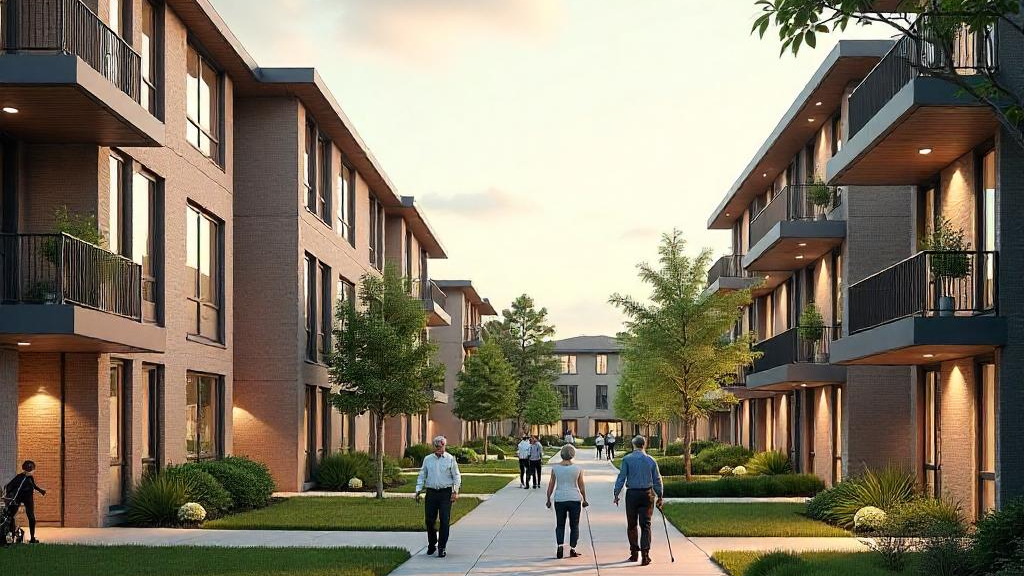
We Asked AI About the Future of Senior Care in 2075 – Here’s What It Told Us
What will the future of senior care look like in 50 years?
- AI and smart tech will enable home-based care at scale – Continuous monitoring and virtual companions will deliver institutional-level care in familiar settings
- Extended lifespans create new care categories – “Young seniors” at 75+ will need different services than traditional elderly care models
- Climate resilience is essential – Future care must include community-level emergency preparedness and self-sufficient support systems
Read Time: 6 minutes
We prompted an AI to imagine itself as a senior living advisor in 2075 Canada, exploring how the future of senior care might evolve. The vision it painted of senior care transformation was both fascinating and surprisingly hopeful.
The End of Nursing Homes as We Know Them
According to our AI advisor from 2075, traditional nursing homes have become relics of the past. The transformation began after what they call the “demographic crisis of the 2030s,” when nearly 30% of Canadians were over 65. Instead of moving seniors into isolated facilities, communities have been completely reimagined.
“Our Aging-in-Community Networks have replaced traditional nursing homes almost entirely,” the AI explained. “Instead of moving seniors away from their neighborhoods, we’ve retrofitted entire communities with integrated care infrastructure.”
This means seniors stay in familiar surroundings while receiving the care they need. Smart home technology continuously monitors health through devices as simple as bathroom mirrors that conduct daily health scans, while AI companions provide round-the-clock cognitive and emotional support.
Living Longer, Living Better
Perhaps the most dramatic change our AI described was in human longevity itself. Advances in longevity medicine have extended the average healthy lifespan to 95-100 years, with many people remaining sharp and capable well into their 90s.
This has created what the AI calls “young seniors” – 75-year-olds who are still working, volunteering, or even starting new careers. The traditional retirement age has become meaningless when people can expect decades of healthy, productive life ahead of them.
Communities That Actually Work Together
The housing crisis of the 2040s (as predicted by our AI) led to an unexpected solution: intergenerational housing cooperatives. These mixed-age communities weren’t just born out of necessity – they became wildly popular.
“Seniors contribute wisdom and childcare while younger families provide tech support and physical assistance when needed,” the AI noted. It’s a model that benefits everyone involved, creating natural support networks that span generations.
Virtual Reality as Medicine
One of the most intriguing developments the AI described was the widespread use of virtual reality therapy centers. For seniors with mobility limitations, VR technology offers unprecedented freedom – the ability to travel anywhere, visit with AI recreations of deceased loved ones, or maintain social connections across vast distances.
“It’s been transformative for mental health,” our AI advisor emphasized. What sounds like science fiction today has become an essential tool for senior wellbeing in this imagined future.
Climate Change Shapes Everything
The AI’s vision wasn’t naive about future challenges. Climate adaptation has fundamentally shaped how senior communities are built. After extreme weather events in the 2050s, all senior living facilities became resilient micro-cities with their own power generation, food production, and medical facilities.
This shift toward self-sufficiency reflects a broader understanding that vulnerable populations need communities that can weather any storm – literally and figuratively.
The Bigger Picture: Integration Over Isolation
What struck us most about the AI’s vision was its emphasis on integration rather than segregation. In this imagined 2075, seniors aren’t tucked away in separate facilities. They’re valued, contributing members of multi-generational societies.
“Seniors aren’t segregated anymore,” the AI concluded. “They’re valued, contributing members of multi-generational communities.”
The Seeds Are Already Being Planted
Remarkably, when we looked at current trends in senior living, many elements of the AI’s 2075 vision are already emerging. Today’s industry reports show growing interest in intergenerational housing, advanced health monitoring technologies, and sustainable community design – exactly the building blocks the AI described as foundational to future care.
The shift toward luxury amenities and personalized services happening now represents an interesting contrast to the AI’s vision. While today’s senior living focuses on premium experiences and market-driven amenities, the AI’s 2075 perspective suggests we’ll eventually move beyond consumer-focused models toward true community integration.
Current sustainability initiatives – solar panels, energy-efficient systems, eco-friendly materials – appear to be early versions of the climate-resilient micro-cities the AI described emerging after the extreme weather events of the 2050s.
Perhaps most telling is how today’s baby boomers are already demanding more active, technology-integrated lifestyles in senior living. The AI suggested this generation’s refusal to accept traditional institutional care would drive the transformation toward community-based alternatives.
What This Means for Today
While this is just one AI’s imaginative projection, it raises important questions about how we’re preparing for our aging future. Are we thinking boldly enough about alternatives to traditional senior care? The current industry trends suggest we’re moving in the right direction, but are we moving fast enough?
How can we accelerate the shift from segregated senior communities to integrated, multi-generational neighborhoods? What would it take to prioritize community resilience and climate adaptation in today’s senior living developments?
The AI’s vision suggests that the future of senior care isn’t just about medical advances or new technologies – it’s about fundamentally reimagining how different generations live, work, and care for each other. And based on current trends, that future may be closer than we think.
What do you think about this vision of the future? Are there elements you’d like to see implemented sooner rather than later? The conversation about aging in Canada is just beginning, and every voice matters in shaping what comes next.

Comments 1
Pingback: High Tech, High Touch Senior Care - myCareBase In-Home Senior Care